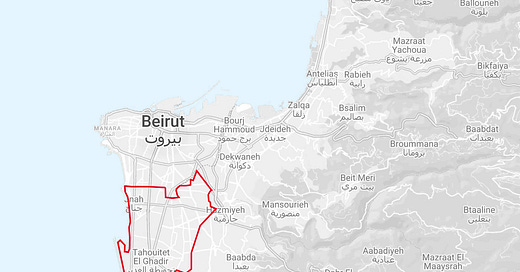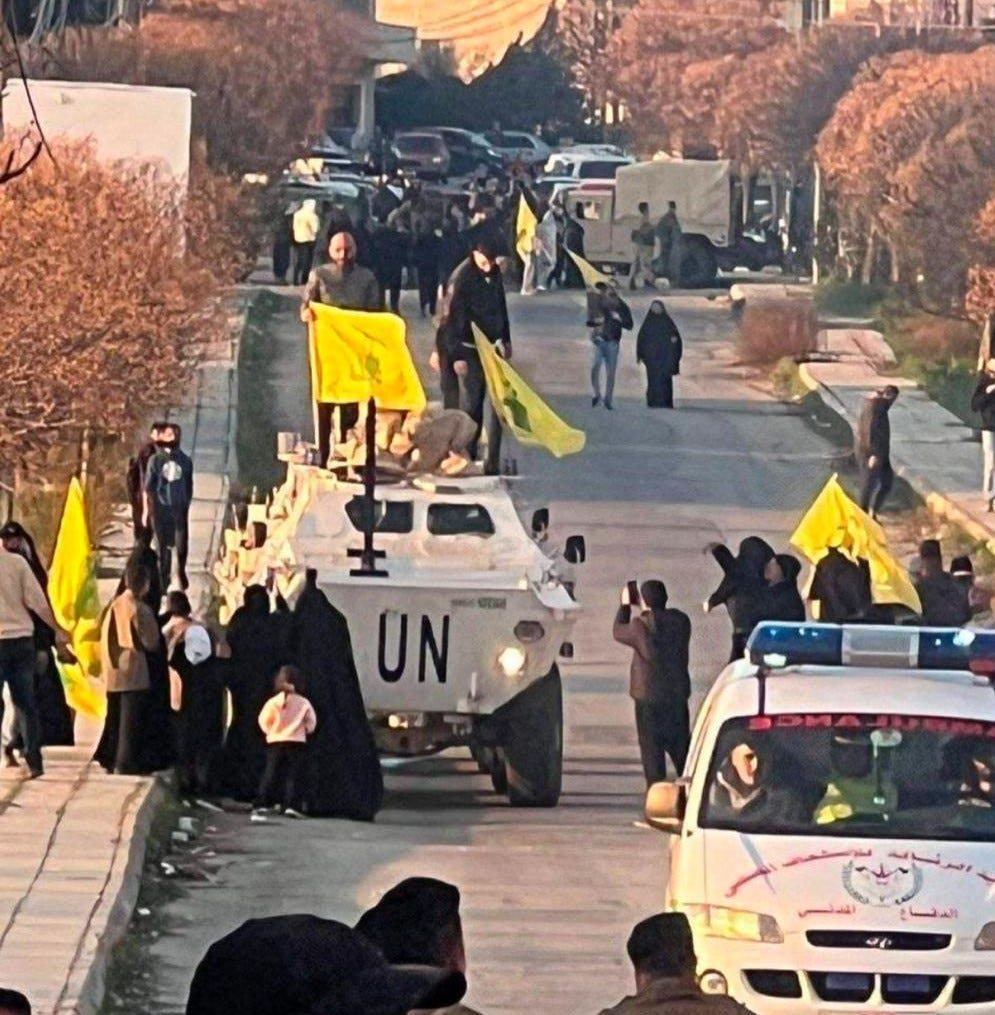Hardly a day passes that we don’t see evidence of being watched—not by people following us—but by the cold eyes of video cameras. Whether in 7-Elevens, apartment buildings, or dangling from poles and wires over streets—cameras are often watching us—especially in urban environments. They unobtrusively capture and store a digital record of our movements. A record that follows us from our homes to the stores we shop at to where we work and play.
The same is true in the six-square-mile Dahiyeh region in the southern suburb of Beirut located between Lebanon’s international airport and Beirut’s city center.
There sits Hezbollah’s headquarters. Entering Dahiyeh feels like leaving Lebanon and entering a different state. Visitors see the green and yellow flags of Hezbollah and enormous posters of Hezbollah’s heroes staring down at them, including recently killed Hassan Nasrallah.

There, before October 7, a million people lived—mostly Shiites—in cramped quarters separated by narrow roads and alleyways. Below them, snaked Hezbollah’s secret bunkers, weapon storage areas, weapon production factories, and tunnels. That was the situation until the fall of 2024 when many evacuated the area (temporarily for a large number) and many of Hezbollah’s facilities were destroyed after the IDF stepped up its response to Hezbollah’s attacks on Israel.
Also present in Dahiyeh were video cameras and monitors. Lots of them.
Just like in western societies, Dayiheh’s cameras were in shops and stores, part of private security systems for individuals and money changers, and in municipal locations. Their lenses that pointed inside and at the streets captured the movements of people both innocent and complicit with Hezbollah’s terrorist agenda. Behind the counter, bored attendants likely rarely looked at the real-time images displayed on monitors within their view. But was someone else looking?
An article I read in The Cradle, titled The eyes and ears that decapitated Hezbollah, astounded me. So did follow up research I did.
Since October 8, 2023, and especially in September and October of 2024, Israel embarked on a concerted campaign to eliminate Hezbollah’s leadership. That campaign included Israel’s surprise pager and walkie-talkie attacks on September 17 and 18, 2024. But it also included targeted strikes using bombs delivered by planes and drones against many Hezbollah leaders, including the bombs on September 27, 2024 that killed Hezbollah’s leader, Hassan Nasrallah, and then within a week, his successor. Both of those assassinations, and many others, occurred in the Dahiyeh. Coincidence? Or was there something more?
It turns out according to the Cradle article that many of the numerous security cameras in Dahiyeh were built by a Chinese company called Dahua Technology. They were cheap and functional. But they had vulnerabilities. In 2017, researchers discovered a defect that permitted remote logins that could give access to their video feeds. In 2021 more vulnerabilities were reported that would allow the camera’s digital captures to be hijacked. Also, because in later years the cameras would save their digital imagery in the cloud, where they were stored provided another venue for attack and capture by outsiders. The Cradle article reported that in 2021, 1.2 million Dahua cameras worldwide were exposed to outside exploitation. Then, in 2023, another report suggested that hackers could embed into at least some Dahua cameras by using QR codes. Recognizing the potential flaws of Dahua cameras, the United Kingdom banned their use in sensitive government buildings. Soon, Australia followed suit, removing them from defense facilities. But there is no indication that on the streets of Dahiyeh that the Dahua cameras in service there were patched or replaced.
In parallel, Israel has long had a vibrant cyber industry. Without going into boring detail, my review of one Israeli company’s website left me with little doubt that technology exists to exploit IoT (the internet of things of which security cameras are a part of). And, that Cradle article I’ve been referring to strongly suggested that Israel used such technology to obtain intelligence that facilitated tracking Hezbollah’s leaders by using AI driven software to create movement maps of those leaders caught in the video feeds. Thus, it is likely that type of technology helped discern where Hezbollah’s leaders congregated, exposed their supposed safe houses, and coupled with facial recognition software that quickly accesses databases, enabled the rapid employment of precisely targeted weapons to kill them immediately upon discovery or when Israel felt the time was right.
But stealing camera video and applying facial recognition software was not the only trick likely up Israel’s sleave. Since some of the surveillance systems in place in Dahiyeh also recorded sounds, Israel may well have surreptitiously hacked into those systems and used voice recognition software to analyze those captured digital vocal imprints, thereby augmenting or confirming the captured video in order to establish real time locations of targets.
And there is more—interception of signals.
Since radios were invented, combatants have tried to listen to what the other side says and decipher any code used to mask the messages. Listening in was rather easy because those transmissions were done on one frequency. Therefore, during World War Two, to stymie Japan’s attempt to decipher secret American radio communications, the United States Marine Corps employed Navajo Indian code talkers to speak in code on radios in the little-known Navajo language. This double whammy of encryption and a little-known language worked. But over time, because of modern cryptology techniques and technology, this method for thwarting interception and deciphering communications no longer could be relied upon. Nor could talking in code alone. Something else was needed.
That something else for some was implementation of a technology called Frequency-Hopping Spread Spectrum (FHSS). Essentially, FHSS employs rapid changes of the frequency used to communicate. Now, rather than using one frequency to broadcast radio transmissions, multiple frequencies would be used—one after the other. Theoretically, FHSS technology ensures that each new frequency used will only be known to the sender and receiver thus leaving anyone trying to listen in chasing the messaging—sort of like trying to follow someone that keeps changing the passageway they are using and leaving no sign of the choices made. The Cradle article likens breaking FHSS enabled communication to trying to listen into a conversation composed of words, spoken one at a time, from different rooms, floors, or even buildings.
Because the Iranians suspected the United States was listening into its communications, the Iranians developed FHSS technology and gave it to Hezbollah. Since then, for more than two decades, Hezbollah has relied on a combination of encrypted communications and FHSS to thwart Israel’s signal capture attempts. As a result, during the 2006 war between Israel and Hezbollah, Israel’s signal intelligence did not intercept Hezbollah’s transmissions to the level deemed necessary. This spurred much successful effort in Israel after that war ended to correct the problem. By establishing patterns of transmission and then using AI to then predict the next frequency which will be used, the Cradle article intimated that Israeli built technology can now decrypt Hezbollah’s conversations captured by monitoring the changing frequencies, establish vector points of transmissions, and also use circulating drones to triangulate locations for targeting. All very mysterious, but very real and deadly for Hezbollah.
The pager attacks proved that Hezbollah’s once vaunted internal security had lapsed at least somewhat over the decades, likely due in part to distractions emanating from its involvement in Syria’s Civil War, lowering of recruiting standards to obtain the manpower to fight that war, the exigencies of the war it started with Israel on October 8, 2023, and plain old error and misplaced confidence. That, along with Israel’s penetration of the Internet of Things and improved Signal interception coupled with Hezbollah’s failure to anticipate Israel’s successes probably led to many of Hezbollah’s leaders losing their lives which eased Israel’ path towards gaining the upper hand.
Nevertheless, we should not be so quick to deride Hezbollah’s security operation because Israel has had its failures too. In documents seized by the IDF inside Gaza, Israel learned that Hamas had also been engaged in video camera chicanery. In many of Israel’s Kibbutzim bordering Gaza, residents there employed security cameras as part of their security apparatus. Like Israel in the Dahiyeh, Hamas penetrated those systems and reportedly gained access to dozens of security cameras through which Hamas obtained important intelligence for their murderous attack. Apparently, the IDF knew that Hamas had hacked some of those systems but failed to address the issue before October 7. So, Israel also had its failures dealing with cyberattacks on unsecured camera systems.
The lesson of this story is not of Israel’s prowess or Hezbollah’s failures. Instead, it is that in the cyber world an advantage held by one side over the other can be devastating. But also advantages wax and wane. Hezbollah’s cyber defenses were up in 2006 and down in 2024. Hamas’ cyber offensive capability was up in 2023, at least for supporting their attack on October 7. But tomorrow could be something different.
And so, Israel and its supporters must never be overconfident or complacent because unseen a cyberwar rages capable of impacts small and large.
A Special Request
If you think this article of value, please share it with others. Please also consider indicating if you see value in the article by “liking” it or adding a comment. Doing so helps me determine the subject of future articles that you might find beneficial and, through social media, broadcasts my work to a wider audience.
Hezbollah’s Leadership Faces its First Strategic Test—Written by Dr. Yossi Mansharoff for the Alma Research Center and Walla—March 26, 2025

The Trump Foreign-Policy Team’s Real Problem—Written by Jonathan S. Tobin for Jewish News Syndicate—March 26, 2025
UNFIL Must Leave Lebanon If It Cannot Restructure—Written by Sarit Zehavi for the Alma Research and Education Center—March 17, 2025

WATCH: Where was UN, Red Cross During My 491 Days of Captivity, Eli Sharabi Asks UNSC—Written by the Jerusalem Post Staff—March 20, 2025

Israel Applying Lessons Learned from October 7—Written by Yaakov Lappin for The Jerusalem Strategic Tribune—March 2025
Israel's New Doctrine: Crushing Hezbollah, Not Just Deterring - Analysis—Written by Yonah Jeremy Bob for the Jerusalem Post—March 23, 2025
Sinwar Documents Reveal Scenarios for Israel's Destruction—Written by Shachar Kleiman for Israel Hayom—March 13, 2025
The Iran Files: Proof of Iran's Direct Role in Planning Oct. 7—Written by Nadav Shragai for Israel Hayom—March 13, 2025
Time to Revise Israel’s Military Doctrine — Written by Professor Efraim Inbar for the Jerusalem Institute for Strategy and Security—March 17, 2025

SPECIAL REPORT: In Identity-Torn Golan Heights, Druze Dream of Peace with Syria—Written by Jotan Confino for the Jewish News—February 7, 2025

Syrian authorities continue crackdown on Hezbollah and its affiliates—Written by Ahmad Sharawi for FDD’s Long War Journal—March 18, 2025

Most Palestinians Would Relocate From Gaza Strip if Given Opportunity—Written by Jerusalem Post Staff-March 22, 2025

‘Blood Libel’: Israel Slams UN Report Claiming it Committed ‘Genocidal Acts’ in Gaza—Written by Times of Israel Staff and Agencies—March 13, 2025—Even as much as I have been shocked by the UN’s craven behavior, this took the cake as far as I am concerned.
Israel’s Struggle with Hezbollah—A War Without End is now available in eBook and hardback format on Amazon and IngramSpark. This compelling narrative explores Hezbollah’s origins and cancerous growth, traces Israel’s response, and reveals Israel’s present readiness to meet Hezbollah’s challenge.
Cliff Sobin
Important Link—Alma Research and Education Center: Understanding the Security Challenges on Israel’s Northern Border












Thank you for your comment David
Incredibly detailed research and analysis. And, the main message to come out of this - Israel must avoid overconfidence and complacency.